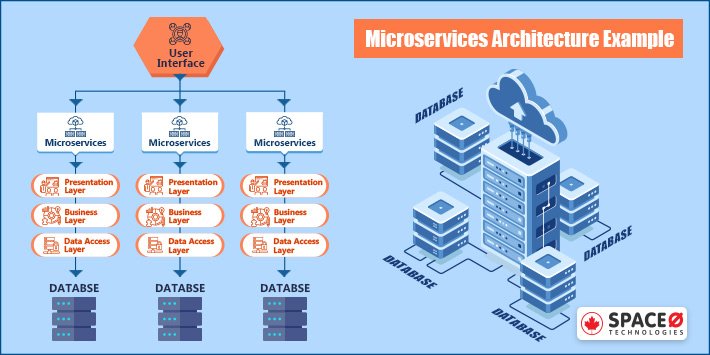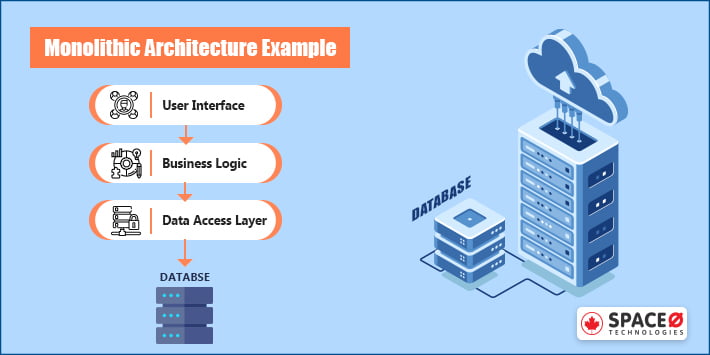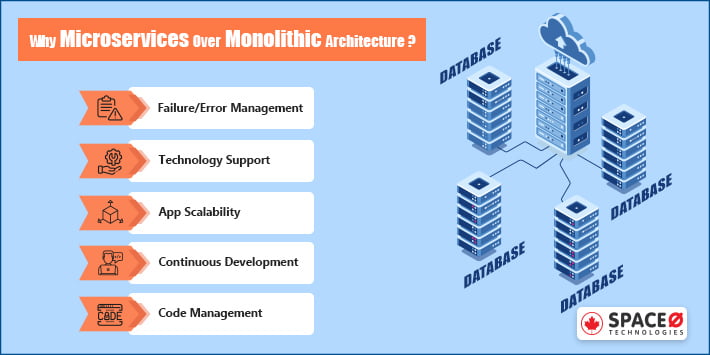If you want to develop scalable and powerful software, choosing a proper software architecture is most important from the beginning.
When it comes to choosing between two architectures, decision-making becomes difficult. As there are two famous architectures: microservice vs monolithic, choosing the right software development architecture becomes even more difficult.
So, we wrote this article to clear your doubts on both the architecture and get to know about the complete difference between microservice vs monolithic.
Let’s get started.
Table of Contents
What is Microservices Architecture?
Microservices is a novel concept designed to address the need for large-scale application development as a group of loosely connected, autonomous services (microservices) interacting through a network.
In simple words, microservices architecture is a collection of smaller independent units that execute each operation of the application as a separate service. So all of the self-contained services have their own logic & database and perform specific functions as well.
What is Monolithic Architecture?
Monolithic is a traditional software development approach in which the whole operation of the system is centered as a single, autonomous entity on a single application. It is unified and all the functions are handled and served in one location.
The architecture comes with a single system of development that allows for developing a whole application. An app has its inner structure, for sure, consisting of a database, customer-side interface, business logic, but it still remains an indivisible entity. Where applicable, it comes with a single executable binary as well.
Microservices vs Monolithic Architecture: Differences
One difference is already clear that microservices is a modular approach while the monolithic approach is unified. But, let’s compare both architectures based on their other functionalities and capabilities that will clear all the differences.
| Point of Difference | Microservice Architecture | Monolithic Architecture |
|---|---|---|
| Approach | Modular approach | Unified approach |
| Programming Language | DevOps, Docker, Kubernetes, Lambda | .NET, Java, PHP, or Ruby, Python/Django |
| Tech Stack | Multiple technology Stack | Single technology stack |
| Learning Curve | High | Low |
| Codes | Each component and microservice module has its own codebase | A huge single code base for the entire module |
| Costs | Initial costs are higher but can reduce while operating | Initial costs are lower but can increase while operating |
| Agility | Use different languages and technologies for different company needs | Can not implement new technologies and programming languages |
| Development | Different teams can work on the different process at the same time | Teams have to work on the development process simultaneously |
| New Updates | Fast updates due to the independent nature of services | New updates will take time due to internal dependencies |
| Testing | Each component has to be tested individually | End-to-end testing of the entire modules |
| Security | Data security may raise questions due to API gateways and vendor lock in | Secure data consistency due to single service |
| Failure | A breakdown of one service has no effect on other systems | One failure could cause the whole system to go down |
| Scalability | High | Low |
| Deployment | System deployment for each service will be conducted individually | Entire system deployment at once |
If you still have a doubt, let’s take an example of each and understand it better.
Microservices Architecture Example
There are 2 components when it comes to microservices architecture for your app development,
- Main app
- Microservices
Now, here the most important part is the interaction between the main app and microservices.
Main App → Microservice → API Gateway

Netflix is a practical example that has developed into a microservice infrastructure lately that makes it easy to obtain material from different outlets, get it into its networks, process it, and seamlessly deliver it to their consumers. You see, this is a step by step microservice architecture that connects each operation with each other.
Along with Netflix, the other big players who use the architecture microservices approach are Google, Amazon, Uber, eBay, Groupon, and Coca Cola.
Monolithic Architecture Example
If we still talk about Netflix, it used to use a monolith structure before it had successfully moved to microservices. The monolithic framework for apps consists of several elements, including the StoreFrontUI that incorporates the user interface, along with some credit checking, service retention, and backend services in a single unit.

As you can see, monolithic applications have large codebases, considering their wide reach. The fact that it is a single unit structure, Netflix was struggling with increasingly increasing pains and frequent outages due to a large database. It was difficult to handle business processes with software complexity. Making a minor adjustment to a particular feature was causing the whole framework to be compiled and checked, which goes against the agile software development services. One of the reasons why Netflix moved to microservices!
However, most small businesses are still using monolithic architecture and it works well with them. So, if your business is still small, you might consider giving it a chance for your software application development, depending on your needs. The key advantage of monolithic applications is that you will have fewer factors to think about as they are typically easier to deal with.
Can’t decide on suitable software architecture for your business?
Share your requirements with us and we will guide you.

Moving ahead, below are the benefits of microservices and monolithic architectures and their drawbacks, to help you consider the best one. Take a look.
Pros and Cons of Microservices
| Pros | Cons |
|---|---|
|
|
Pros and Cons of Monolithic
| Pros | Cons |
|---|---|
|
|
How to Choose Between Monolithic and Microservice Architecture?
Moving ahead, while it seems difficult to choose the best-suited architecture for your business bottom line, we have curated a list of factors that you may want to concentrate on. Read below.
When to Choose Monolithic Architecture?
- When you are a startup and small-sized business
- When your applications do not demand high business logic
- When your business does not consist of high technical expertise
- When you want a quick client side application launch
- When you build a minimum viable product (MVP)
- When your domain is simple
- When you have a lean budget
When to Choose Microservice Architecture?
- When you want to build a large-scale application solution
- When you are not in a rush and have a lot of time on your hands because the database architecture of microservices needs careful planning
- When your business team is skilled with the technical expertise of software engineering for enterprise applications
- When you plan to build large applications with multiple modules and user journeys
- When you want to build multiple independent teams to work on the application
- When you have enough resources to handle the business transactions, business process, and different services
Want to build an app solution using microservices architecture?
Our experts can develop all types of solutions.
Why Microservices Over Monolithic Architecture?
Though it depends on the business needs, if you are thinking about a long-term journey and considering the available resources(budget, time, team), below are the top reasons why you should choose microservices architecture.

-
Failure/Error Management
As all services are independent of each other in a microservice architecture, any halt in a network latency will leave the rest of the processes unchanged. A memory leak of one service, for instance, would only affect the particular service of the server-side application.
On the other hand, in a monolithic architecture, any misbehaving element would bring down the entire application since all resources are integrated and dependent on each other.
-
Technology Support
When you opt for a microservices architecture, developers have the advantage of using multiple tools, languages, frameworks, and OS to build enterprise applications for business. This reduces dependence on a single application stack and long-term interaction with it.
While for a monolithic application, the development team is required to adhere to a single technology which has its own drawbacks. If a system the application uses becomes outdated over time, it may be difficult to move to a newer, improved framework.
-
App Scalability
When an application’s code base has achieved a certain size, splitting the production team to oversee particular functional areas is always a good idea. The UI department, inventory management team, quality management team, all of these multiple services are built as independent modules in the case of architecture microservices. Teams can then be broken and function separately, allowing them to modify and upgrade output to scale the program easily.
On the other hand for a monolithic application, scaling is the biggest problem for developers. Since there is a common code base that accommodates all programs, teams do not function separately on separate components. And even though they do, the team has to organize during the process.
-
Continuous Development
Each part of an entire application is independently designed, implemented, managed, and scaled in a microservices architecture. This suggests that an improvement in one application infrastructure would leave other systems unchanged.
On the other hand, a monolith architecture has a broad codebase that has dependent elements. Such an infrastructure layout is an obstacle to regular deployments, so the whole application needs to be redeployed to upgrade a single component. This not only interferes with current activities but also affects the operation of linked services.
-
Code Management
As you know monolithic application codebase is single, unified, and huge. So sometimes, it becomes hard for developers to understand and handle, particularly those who are new to the project. This, as a result, will slow down the process of growth. On the other hand, the codebase in the microservice application is broken into small classes of code and is more efficiently handled relative to a monoliths program.
Also, find out how much it will cost to develop an app for your project.
Frequently Asked Questions
-
Is microservices better than monolithic?
If your business is large, yes, architecture microservices are much easier and better than monoliths when it comes to scalability, failure handling, technology, coding, etc.
-
What is the difference between monolithic and microservices-based architecture?
A monolith program is essentially installed with load balancing on a collection of similar servers. A microservice program, in comparison, usually consists of a large number of independent services.
-
What are the advantages and disadvantages of monolithic vs microservices architectures?
Monolithic architecture is fixed and linear, but one major drawback of monolith architecture is tight coupling. On the other hand, the microservices application is loosely coupled and highly scalable, but when it comes to testing and deploying, it is more time-consuming than monoliths.
-
What are the characteristics of a good Microservice?
- Microservices are deployed independently
- Each service have a separate database layer
- Each service have an independent codebase
- Each service to be tested in isolation without any service dependencies and side effects
- Developers can implement each service independently with a variety of technologies
Conclusion
If you think adopting an architecture for microservices is a one-size-fits-all solution, it is still wrong. Despite being less and less common, a monolith has also its effective and long-lasting benefits that function well with many small businesses. Depending upon the business needs, the choice among monolithic vs microservices will always differ. So if your company is struggling to decide which software architecture can fit your business goals, contact us at your time. We, as the best app development firm, will guide you in every development process and deliver the best results possible. See you there!
 By
By 





